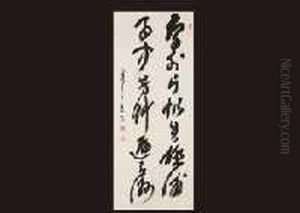Yamaoka Tesshu Paintings
Yamaoka Tesshū, also known as Ono Tetsutarō or Yamaoka Tetsutaro, was not primarily known as a traditional artist but as a Japanese swordsman, military strategist, and philosopher. Born on June 10, 1836, in Edo (present-day Tokyo), Tesshū is famed for his mastery of swordsmanship and his role in the politics of the Meiji Restoration. Although he is not celebrated for visual arts, his calligraphy has been highly regarded and is often considered a form of art in its own right.
Tesshū’s biography is deeply interwoven with the turbulent period in Japanese history as the country transitioned from the Tokugawa shogunate to the modern Meiji government. He was originally trained in the art of swordsmanship under the Shinkage-ryū school, and later, he developed his own style known as Itto Shoden Muto-ryū. Tesshū's dedication to the martial art led him to achieve a profound spiritual realization, referred to as 'kenzen ichinyo' (the sword and Zen are one), which influenced his approach to both swordsmanship and life.
Apart from his martial prowess, Yamaoka Tesshū served as a retainer to the Tokugawa shogunate and, later, a government official under the Meiji regime, playing a crucial role in the peaceful surrender of Edo Castle during the Meiji Restoration. This act helped prevent unnecessary bloodshed and contributed to the relatively peaceful transition of power.
Tesshū is also known for his deep Zen practice. He was a lay student under the famous Zen master Sōen Shaku and pursued enlightenment with the same vigor he applied to his martial arts. His calligraphy, which is revered to this day, is seen as an expression of his Zen understanding and often features bold strokes and a dynamic flow, embodying the principles of his martial and spiritual teachings.
He founded the Ittō Shōden Mutō-ryū school and also established the Shumpukan, a dojo in Tokyo where he taught swordsmanship, Zen, and calligraphy until his death on July 19, 1888. Yamaoka Tesshū's legacy continues to influence both martial artists and those who practice Zen and calligraphy, making him an important figure in Japanese cultural history.

